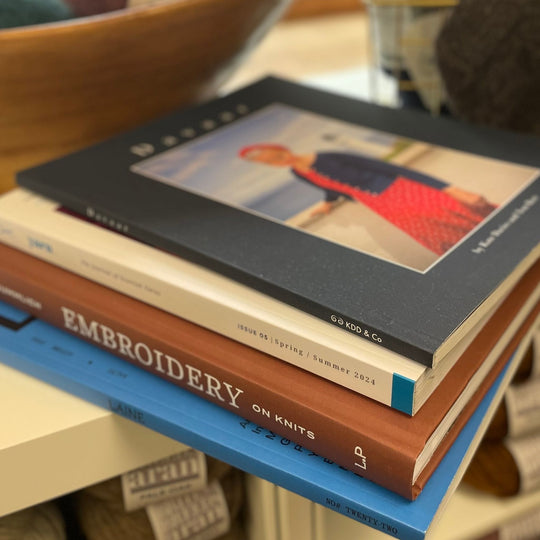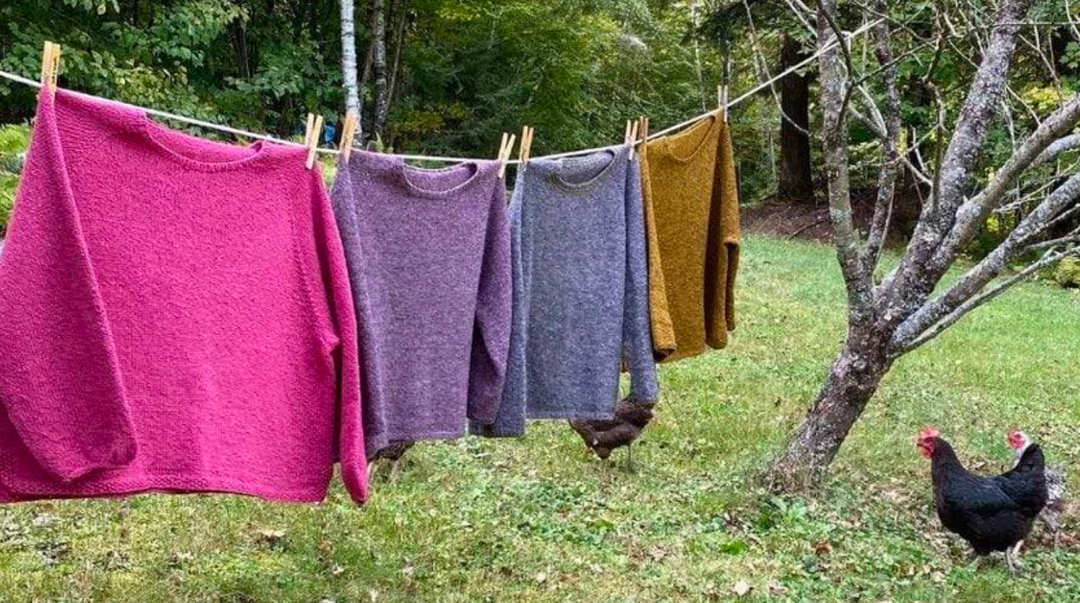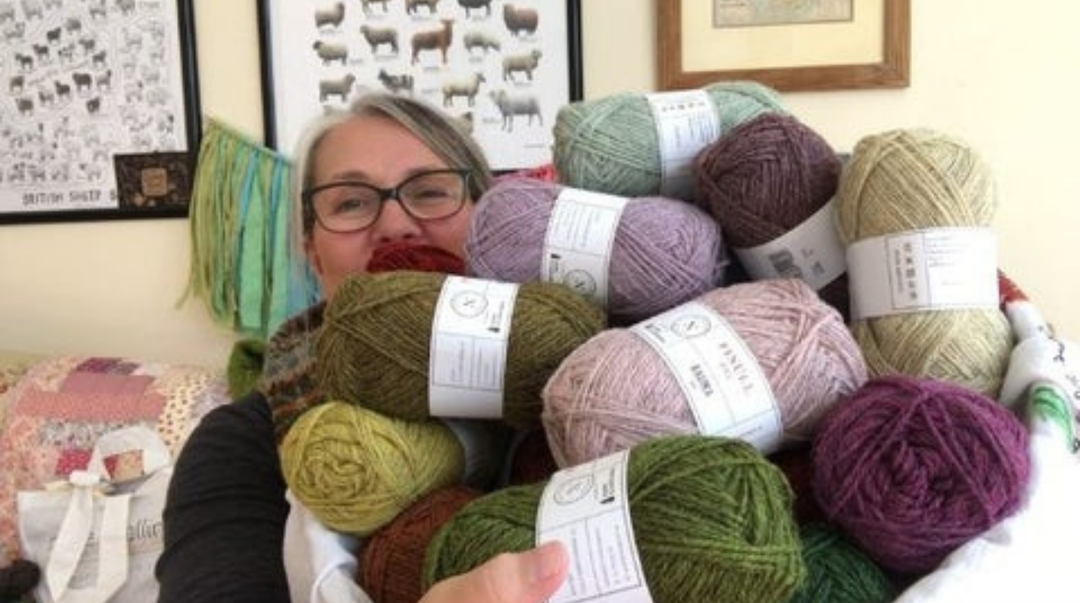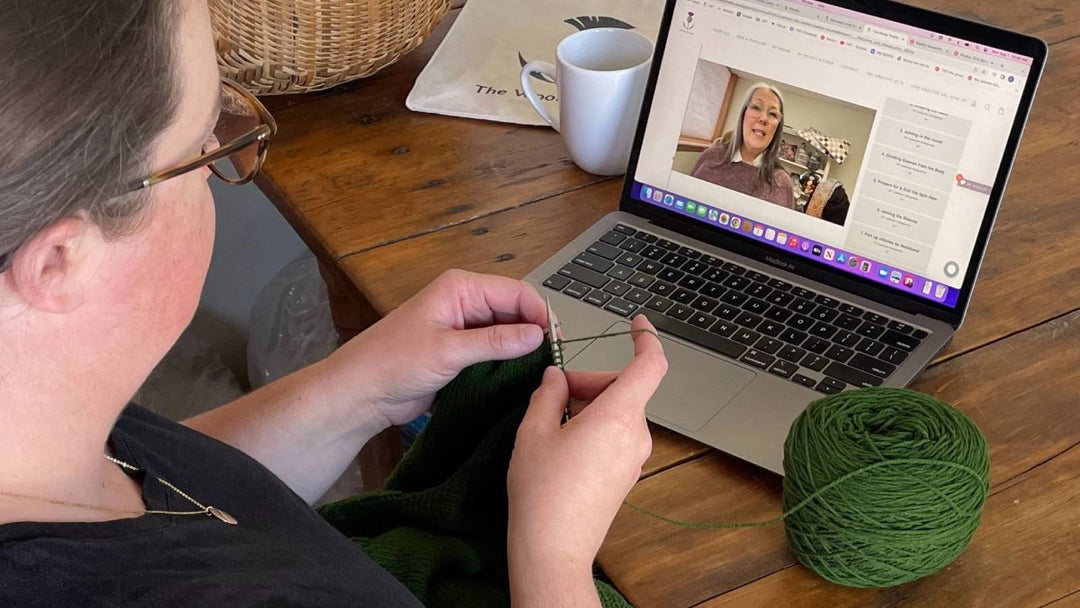Meet the Maker: Jamieson's of Shetland Tour with Mary Claire
I bought my first ball of Jamieson’s of Shetland sometime in high school. Drawn to its ballband and the depth of each yarn color, this skein started my love for Shetland wool. I’ve always thought the sheep on the logo looked like a mother and her lamb, so it felt apropos to be buying my mom and me tickets to the factory tour in Sandness for last year’s Wool Week – which, I must add, sold out almost as quickly as Beyoncé tour tickets.

Picture of “Welcome to Shetland” sign in shades of blue, red, and white under a blue sky

map route from Lerwick northwest towards Sandness on the opposite side of the island
Meeting in front of the iconic "Welcome to Shetland" sign on a rare sunny day, we boarded our minibus with other wool superfans and Garry Jamieson: 5th Generation Jamieson and man of many hats. That day, Garry wore the hat of tour guide: giving us small details of the homes and land we passed by.
When we arrived at the factory, Garry handed out microphone packs in a, to be expected, fairisle knit fabric. We’d be entering a working factory with all its accompanying noise, so these would help us hear the ins and outs of this Woolly Wonka’s Wonderland.

Close up of my mom’s mic bag in shades of teal, salmon, grey and pink

Garry handing out microphone pacs in various fairisle print

My mom Terri modeling her mic bag and Boneyard shawl by WestKnits in lime green, grey and black
Built especially for Jamieson’s of Shetland in 1981, the Mill at Sandness handles every stage of the process from wool sorting to scouring, dyeing, and spinning. Garry showed us how he sorted out the wool, separating out the occasional Merino or Texel so that only pure Shetland wool is spun into yarn. Jamieson’s of Shetland only uses 100% Shetland wool, having spun their first all-Shetland wool in 1978. You can see these bags of wool everywhere - some dyed, some natural, by the entrance, on the top floor above, by the sorting station.

Close up of wool in a white bag

Garry explaining the ins and outs of Shetland wool by two fresh fleeces
Here’s where I admit my own shortcomings, while I was able to listen to the tour – the combination of mechanical buzzing and constant visual stimuli means I missed out on some of the finer details of how the scouring, dyeing, and spinning gadgets worked. However, the sheer size of the operation may be better communicated by photos - of which, I took many.

Green Tub of different shades of wool against a blue and grey factory wall

Close up of “Anti-Snarl Devise” with a gauge for “Anti-Snarling Time”

Close up of a large carding machine next to a teal wall
At one point, I got lost. Caught looking at a room full of wool, one of the workers tapped my shoulder and asked if I wanted to jump in. Without even a second thought, I immediately gave him my phone and leaped. To answer your questions – yes it was incredibly soft and no I could not see a thing. To that sweet worker – thank you, that was a memory of a lifetime.

The Wool Filled Room After I had Jumped In
What’s always drawn me to Jamieson’s of Shetland Spindrift is just how multifaceted each color is and we got to see just how these dyelots came to be. The wool is dyed before the spinning process, then using some magic method of color theory a mixture of white, pink, orange, and teal turns into a stunning peach color.

Wool in various colors waiting to be carded together

Close up of the blend of white, teal, pink and orange in my hand

Color Cards for Spindrift and DK on an industrial wall
The wool is then spun onto a cone, turned into balls, mechanically placed into ball bands and then separated into packs of ten. I’ll borrow my mom’s words when I say, it was like witchcraft.
One theme I gathered on our tour was just how dynamic Shetland tradition really is: how the spinning of all-Shetland wool at Sandness relies on a team of people from places on and beyond Shetland. How the decision to include all genders in ‘Up Alley Aa’, the long running viking fire festival, meant people like Garry’s young daughters could be included and continue on the tradition. And nowhere was this evolution of heritage more evident than in their knitting machines.
Garry explained to us they’d developed first of its kind technology that could make traditional Shetland sweaters with up to 13 colors in traditional motifs and various styles including hoodies, crew and v-necks. While the panels are machine knit, they’re still hand pieced together. These stunning pieces, which I’ll add are not that much more costly than buying the yarn to knit one, are then sold in the store on Shetland, on the UK mainland, and as far away as Japan.


Line Up of yarn cones strung to a knitting machine
Naturally I had to say a quick hello and take a selfie with the Shetland ponies in my Shetland sweater. The sweater I’m wearing is one that was machine knit at the mill on Sandness, done in the traditional colors and featuring classic motifs (unfortunately I’ve yet to find a similar hand knit pattern). After a few quick goodbyes, we hopped the bus and headed for Lerwick.

The neighboring Shetland Ponies close to the Mill on Sandness, and a shot of me with my new four legged friends in my Jamieson’s of Shetland sweater
At the Jamieson’s of Shetland storefront on Commercial Street, I snagged the same peach hued lace weight we’d seen wound up (funnily enough on sale as they had been in the “Woolly Wonka” storefront display). Knitting with this yarn now reminds me of the wonder I felt walking around the Mill in Sandness – a magic that, I hope, you’re able to feel through your screen.

Yarn Wall in the Jamieson’s of Shetland Store

The Jamieson’s Knitwear Storefront on Commercial Street
Shop Jamieson's of Shetland Spindrift yarn and yarn sets at TWT!
And get your copy of the Shetland Wool Week Annual here if you haven't yet!






























Thank you for taking us on this magical journey with you! Funny, yet informative! I loved learning about how Jameison’s dyes the wool first, then blends it to make their beautiful and varied selection of wool. Thank you, Wooly Thistle, for supporting Marie Claire and posting her article.
I loved the article and also Jamieson’s yarn. I have bought a number of skeins and love the yarn. I have wanted to go Shetland, and this article made me lust to go there. And the trip to the mill in Sandness put me over the top. I will go there in the next year.
So enjoyed your article. Thank you for raising awareness of this lovely “industry”. Wish I could touch what you touched while on Shetland.
Thank you so much for sharing. I really enjoyed the tour and the ponies.
I will watch this again. Most interesting.
Leave a comment